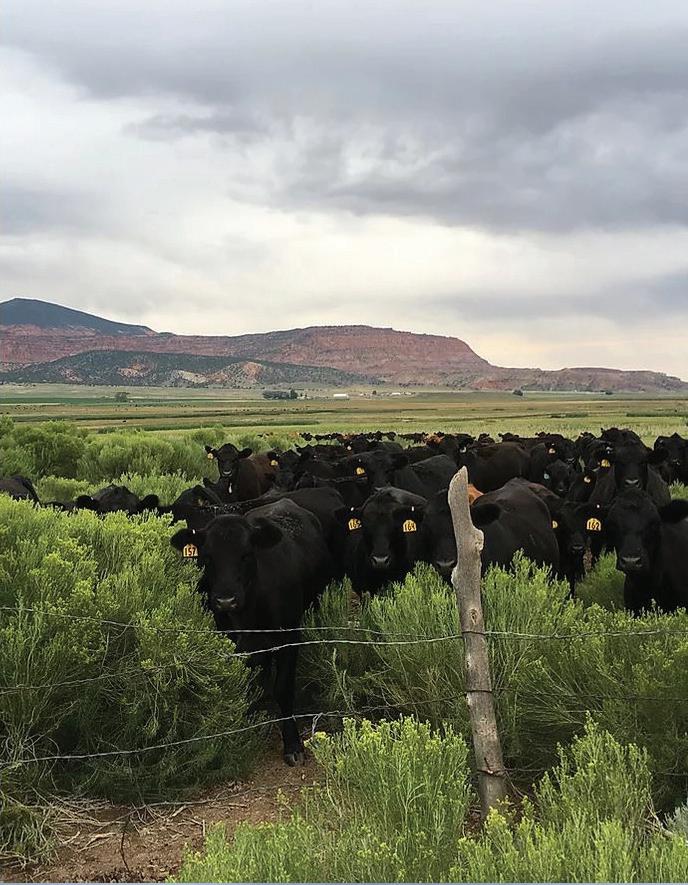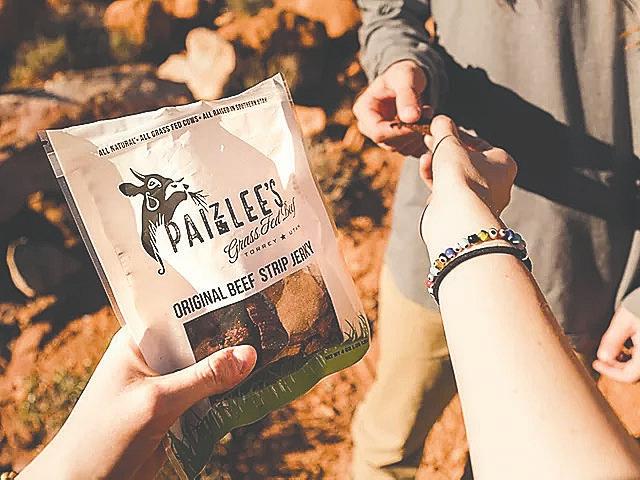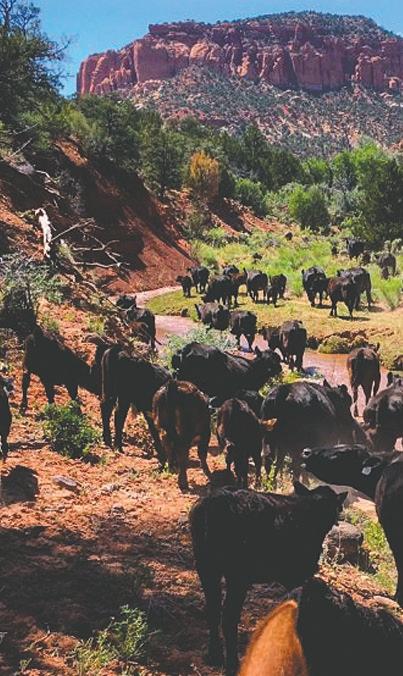
9 minute read
AGRICULTURE
Utah Farm Bureau; Farmers feeding Utah
WRITTEN BY LACIE KOFORD Western Wasatch Contributor
Allen Bennett, a 4th generation farm owner, is just one farmer and rancher who has been hit hard by the economic effects of the current Coronavirus pandemic. His farm, started in 1896 by his great grandfather has been passed down through generations, having a 125-year existence. In 1996 Bennett Farms received the Utah Century Farm and Ranch Designation. The farm includes 600 acres in Davis and South Weber counties and focuses mainly on produce for local distribution. They grow yellow and red onions, different varieties of potatoes, tomatoes, peppers, squash, and watermelon. They truly take great pride in the quality of their products, making sure that the product they are providing is safe, wholesome, and delicious. Bennett states that he “feels pride in feeding neighbors along the Wasatch Front”. He goes on to state that “it brings great satisfaction to watch someone receive products and the enjoyment they show as they consume those products”.
To help farmers and those who are struggling to put food on the table during these unprecedented times, Ron Gibson, President of the Utah Farm Bureau, launched a program early in May called Farmers Feeding Utah. The program aims to help Utah farmers and ranchers as well as families who need food. The struggle for many farmers and ranchers stems from many processing plants closing across the country, making it more difficult for them to make their food available to sell wholesale and to the public. As a result, many farmers have had to let their food go to waste. If farmers can’t sell their products, consumers can’t access those products for consumption, thus leading to more people going hungry and not being able to provide adequate food for their families. Ron states, “seeing examples of that has been among the toughest things I have ever had to experience.”
The goal of the new program, Farmers Feeding Utah, is to provide the opportunity for people to donate online in various denominations, $5, $25, $50, $100 or a custom amount and help provide meals for needy families. Organizers of the program will use money from donations to purchase product from farmers and ranchers, use small local processors to produce it, then donate that food to organizations that provide food to people and families who need it. With this set up, both farmers and ranchers who are struggling to keep their farms up and running, and


families who have been affected by the pandemic financially, can be strengthened.
The Utah Farm Bureau, who is heading the relief program has a mission of inspiring all Utah families to connect, succeed and grow through the “Miracle of Agriculture”. That mission spoke greatly to Lieutenant Governor Spencer Cox as he addressed a small audience at Bennett Farms during a press conference. He stated that “Farming and agriculture is about economics but is so much more than that. It’s a national security issue. We’ve forgotten how important local farmers are for how we live.” Cox continues to encourage that the new normal needs to be better for farmers and ranchers and create an environment where we appreciate and take better care of those who are supplying us with life sustaining food. Farmers are generally very humble and don’t necessarily search for hand-outs, but we can help those farmers who are struggling as well as those who are in need of nourishment by donating to the program or buying product directly from farmers. Cox ends his remarks by stating that Utahns have a history of coming together, especially when it comes to charitable giving.
Gibson encourages any who are willing and able, to please support the efforts through Farmers Feeding Utah so that as a state, we can come through this with a stronger agricultural community and society in the state of Utah. Visit farmersfeedingutah.org to find out more about the program and to find out how you can donate and make a difference. Gibson assures that every nickel donated will go towards providing relief to both farmers and ranchers, and to those who aren’t able to provide sustainable nourishment to their families at this time.

AGRICULTURE
Paizlee’s Grass Fed Beef mixes tradition with innovation
BY MARK SAAL Standard-Examiner
Tradition. Few things are more important to the farmers and ranchers who make up America’s backbone.
And indeed, many of those now toiling in the field of agriculture are steeped in generations of tradition. They do it because this is what their parents did. And their grandparents. And their great-grandparents.
Still, for all of its tradition, this rural way of life has never been easy.
But Benjamin Stutman, a 20-something Philadelphia native who now lives in the small southern Utah town of Torrey, believes there’s a better way of doing things. And he’s trying to convince his ag buddies of this.
“I want to inspire others who are struggling with agriculture, to let them know that there are opportunities,” Stutman said.
The entire population of Wayne County is about that of a good-sized high school, so Stutman said you tend to get to know everybody. And one thing he’s learned over the last few years is that so many of his neighbors are “generational ranchers — and, like everybody else in agriculture, they really struggle.”
Stutman owns and operates Paizlee’s Grass Fed Beef, a two-year-old Utah company that specializes in quality beef and locally famous beef jerky.
“First and foremost, we’re a beef company,” Stutman explains. “So if you’re a vegan, we’re not for you.”
The young businessman may not have the same deep background in agriculture as many of his friends down there in Wayne County, but through trial and error he’s become a quick study and says he’s landed on a formula that can open up new opportunities for cattle ranchers.
“I have no family history in this,” Stutman admits, confessing that the primary reason he started Paizlee’s is that “I got sick and tired of my meat orders getting messed up.”
Through his company, Stutman is trying to show that there’s a better way to raise, market and sell beef. Under the current system, he says, a rancher will raise a beef cow over a six-month period, go through a traditional broker, and maybe get $850 for an animal.
“But I said, ‘Let’s take the timeline from six months






Learn more and shop now at paizlees.com





to 18 to 20 months,” he said.
And off that same animal, Stutman claims the rancher can make between $5,500 and $8,000.
“See, Paizlee’s model is different, and it blows minds in ag,” Stutman said. “We’re able to create a value about seven times the market standard for an animal of the exact same weight and age.”
Admittedly, most of the cattlemen Stutman approached thought his plan was just too good to be true.
“When I came up with this model, all my friends said I was nuts,” Stutman said. “But two said, ‘I’m in.’”
With those two friends, he built Paizlee’s model for grass-fed-andfinished beef.
Stutman said that while tradition is important for those in agriculture, he also believes they need to be thinking outside of the box. He sees a couple of problems with how farmers and ranchers tell their story.
“The problem with agriculture in general is they’re horrific — and this goes for all agriculture — they’re horrific at being the first to educate people,” he said. “Ag is always responding — it’s never at the forefront of getting the message across. And that’s a big problem today.”
A second problem, as Stutman sees it, is that “it’s the only industry where the buyer dictates the price.”
Farmers/ranchers have to simply take what they can get, Stutman says, because they’re land rich and cash poor.
“That’s why the federal government keeps them on the tit,” he said.
Stutman’s model eliminates the middle man.
“Actually, the model I’m proposing eliminates three middle men,” he said. “We’re going direct to the consumer.”
This alternative approach means much of the marketing for Paizlee’s beef is through events like farmers markets and festivals. And when COVID-19 hit, that market dried up.
“Within an hour of the NBA announcing it was suspending its season, we lost close to 90% of our events for the year. So we knew we’d have to somehow recoup that cash flow.”
One of his solutions to the problem? Why, open a restaurant, of course. At a time when many eating establishments were temporarily closing or going under completely, Stutman opened a take-out joint at the junction of State Routes 12 and 24, just outside Torrey.
“Everything is to-go,” he said. “There’s no seating.”
And although located in Torrey, the eatery even has a tie here locally. Stutman put in a coffee bar that uses Ogden-based The Daily Rise Coffee products.
“I think it’s important to use local ingredients,” he said.
Another way in which Stutman is changing things up these days: After finding he had some cuts of meat that weren’t selling as well as the more popular ones, he decided to create a menu to educate consumers. Thus was born “Meat Talk Monday,” a weekly video series that offers simple, tasty recipes for these lesser-used cuts of beef.
“All the recipes I do, you’re able to cook them in your home,” Stutman said. “I can’t bet everybody has a smoker, but I can bet everyone has an oven.”
In the end, Stutman says innovation is desperately needed in agriculture. And the coronavirus may end up being the catalyst to change the current model.
“It’s about the future, it’s not about today,” he said, suggesting that today’s impacts on agriculture will be felt 10 years down the road.
“You have to realize that change doesn’t happen overnight,” Stutman said. “In an iPhone world, everybody wants it in three actions or less — so this is hard to grasp.”
Contact Mark Saal at 801-625- 4272, or msaal@standard.net. Follow him on Twitter at @Saalman. Friend him on Facebook at facebook.com/ MarkSaal.










